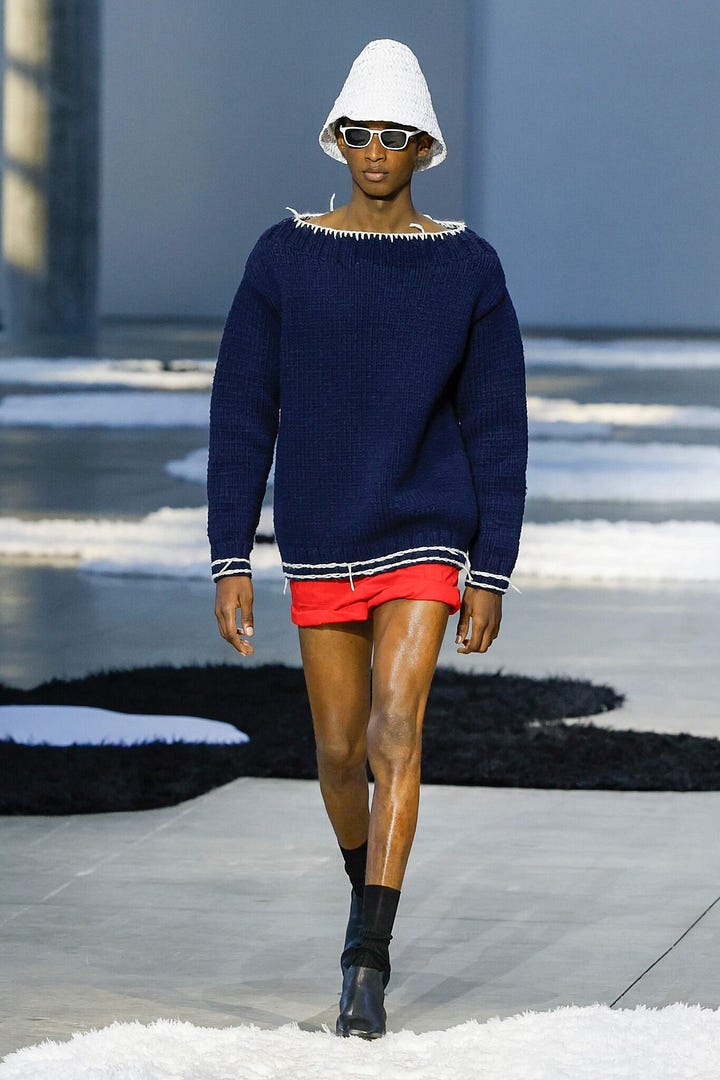Handmade in the USA
Big things from small makers
I’m back home from spending 3,5 days at Paris Fashion Week. “The clothes are hot, but the parties are even hotter,” wrote GQ. The weather, in fact, was the hottest of all — by far. A lot of what happened in Paris I didn’t see. Louis Vuitton’s star-studded show next to the Centre Pompidou, Auralee’s flip-flop frenzy, the complete absence of pants at both Prada and Rier, Jonathan Anderson’s breezy baroque for Dior, Camiel Fortgens’ debut calendar show. So, what did I see? I’m not entirely sure yet.




Of course, I know what my eyes saw. Many insider greats — Noah Johnson, Jonah Weiner from Blackbird Spyplane, Sigurd Blank from mfpen, Phillip Proyce from Lady White, Saager Dilawri from Neighbour, Louis Cheslaw from GQ/Magasin, Oliver Warner from Conkers, Raff Rodfrey from Works & Days — at a get-together at Lady White’s showroom on Wednesday evening. Lots of sun-faded reds, silk (preferably in combination with cotton and/or linen), unconstructed and relaxed suiting, odd pockets, Aurora’s monkish leather slip-ons, signature fabrics, out of this world natural dyes, slightly mismatched styling, and, more generally speaking, independent labels with a singular voice searching for a golden middle way between long-term consistency and instant differentiation. But seeing something is not the same as knowing its real nature, and it’s still early days for that.
While Pharrell’s phamous phriends flocked around the 4th arrondisement, and hundreds of established and emergent brands presented their SS26 collections in showrooms spread across the city center, my thoughts drifted elsewhere — to all those aspiring makers not in Paris. They chose to stay where they are, whether because showing in Paris is too expensive, because they’re not ready for it yet, or because they simply don’t like it and prefer not to go there. That all makes sense. If my sources are right, Paris, Milan and Tokyo are where fashion happens, followed at a great distance by London, Stockholm, New York, and Amsterdam. But not every Paris is located in France, and not every piece of clothing is part of fashion — if you get what I mean. Who knows there’s a tailor in Paris, Texas doing extraordinary double-breasted pinstripe suits. No reason for them to go to Paris, yet every reason for the rest of the world to get to know their work.




This is the premise from which I set out a few weeks ago, reaching out and talking to the best individual clothesmakers from America. Some of them have industry jobs, and do their own work more or less as a hobby. Others are about to launch their own label. Some have a solid fashion background and often design for major names. Others are entirely self-taught. All create pieces entirely handmade in the USA, either as one-offs or in highly limited batches — worn by themselves, their friends and family, and by the occasional customer from Japan, Sweden, or the Netherlands. Many of them don’t have a website, and can only be reached directly via email. Likewise, many of them aren’t stocked anywhere, and do everything made to order. They’re brought together here for the first time, introducing themselves to you in their own, sometimes rather sparing but always well-chosen, words.
Apparently, small was the new big at Paris this year, with large brands seeking intimacy and much needed personal connection. Outside Paris, small has been the new big for some time now, and it’s getting bigger as we speak. You know that. But did you also know of the big things these six small, US-based makers — Never Cursed, Of Nothing, Themness, Bryn Bingham, Slowboat and CSiLLAG — are doing?
Although working solo in their 20-to-25-square-meter microcosms, sometimes separated by thousands of kilometers of urban and rural landscape, they share in at least one fundamental characteristic, apart from a brown/taupe color palette: an approach, typical of so many good clothes from the 2020s, that’s both minimalist and maximalist, simultaneously “less is more” and “more is more.” The minimalism’s about what you see — design, silhouette, style. The maximalism about what you don’t immediately see — yarn, fabric, seams, buttonholes, interior lining. Whatever the exact moniker, here’s your guide to just that: extremely small-scale minimalistic maximalist clothes handmade in the USA.
One final remark: this guide obviously isn’t exhaustive. It doesn’t include the likes of Joseph Walia, Alexander Coltrane, and Jacob Perks, to mention but a few. And that’s just because they were either too busy or not yet ready to show and/or capture the direction of their recent work. It’s another key element of working solo, and on a small scale: you cannot always do everything, and what you do you do exactly when, and only because, it feels exactly right.

